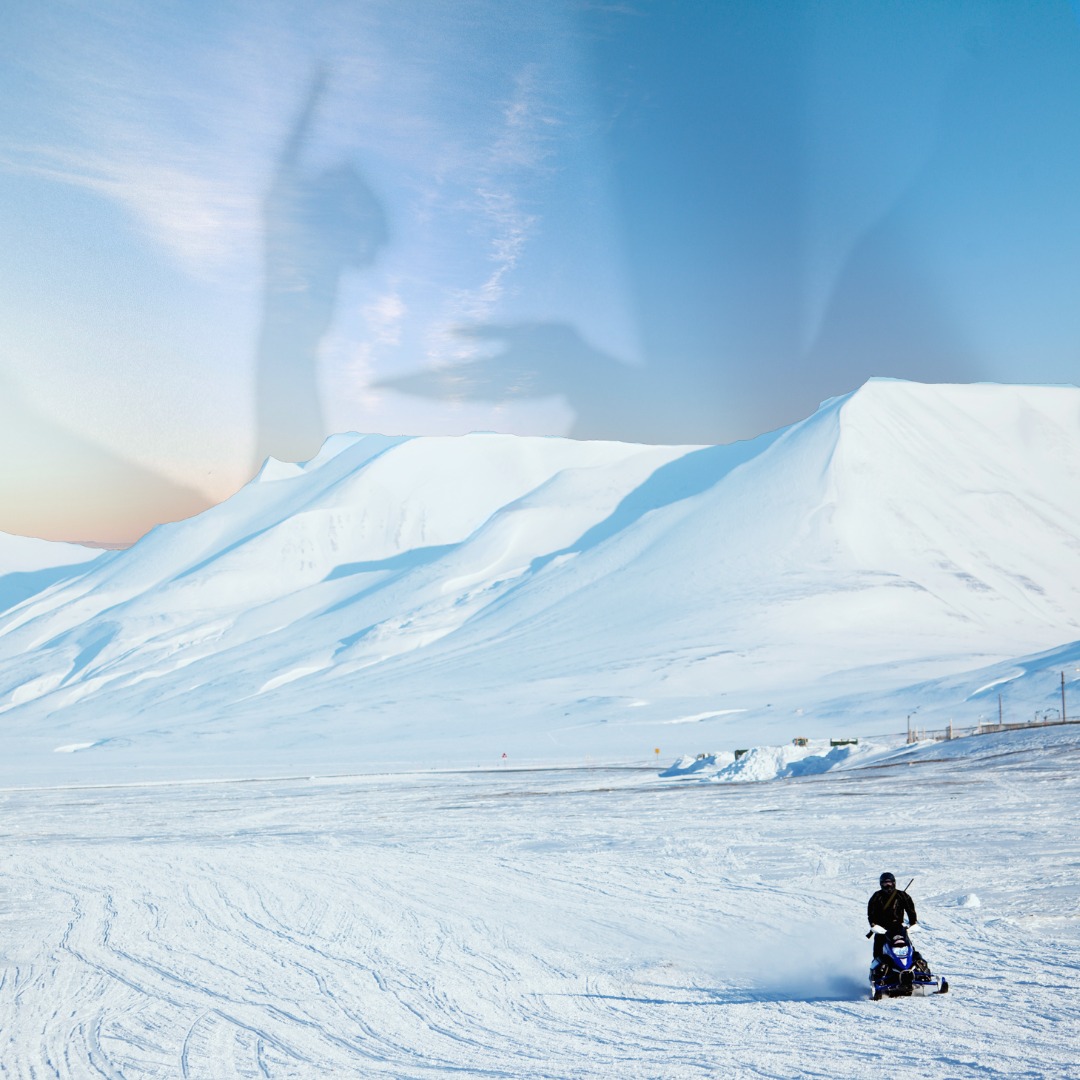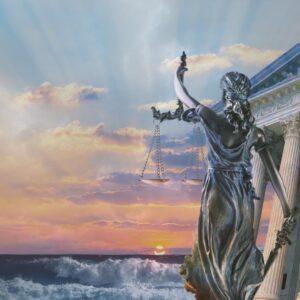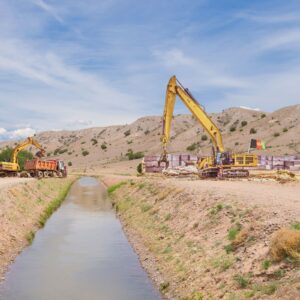
By Norie Wright
Edited by Muhammad Hani Ahsan
Graphic by Norie Wright
Introduction: The Arctic
The Arctic is distant to most of us, far away and seemingly disconnected from the rest of the world. However, the region is one of the most environmentally significant places on Earth, with its glaciers and icebergs holding around 20% of the global supply of freshwater. Ongoing climate crises and geopolitical tensions have led to heightened interest in the Arctic.
The Arctic region has multiple definitions, but the most commonly used is the area above latitude 66.6 degrees North. Its polar opposite, Antarctica, is defined by its continental land mass surrounded by the Southern Ocean. While these two regions may appear similar, both being ice-covered worlds seemingly isolated from humanity, they are extremely different. The most striking difference between the two is how they are governed. The Antarctic Treaty of 1959 states that no one nation may own or claim sovereignty over the continent. It would be “used for peaceful purposes only”, that “Freedom of scientific investigation in Antarctica and cooperation toward that end…shall continue” and “Scientific observations and results from Antarctica shall be exchanged and made freely available” to all of humanity (Secretariat of the Antarctic Treaty 2020). The continent also has no native human population.
The Arctic is an ocean surrounded by five countries with Arctic coastal borders. Eight different sovereign nations lie within the commonly held definition of “Arctic region”, ranging from having coastlines on the Arctic Ocean to having sovereignty over land that falls within the 66.6 degree North latitude. Many populations of humans have lived within the Arctic for thousands of years. Therefore, governance in the Arctic is a complex issue. As the Arctic is an ocean, the United Nations Convention on the Law of the Sea (UNCLOS) is used to determine the reaches of sovereignty in the ocean. According to UNCLOS, each country’s marine exclusive economic zone (EEZ) extends 200 nautical miles beyond their territorial sea boundaries with the additional right to apply for an extended continental shelf claim beyond the EEZ (Olesen 2017). Since the Arctic is a sea surrounded by five sovereign nations, the ocean is thus divided into five different EEZs. An area of High Seas, or an area beyond national jurisdiction extending 200 nautical miles, adds another layer of complexity.

Map of the 200-nautical miles EEZs in the Arctic as of 2016 (Humpert and The Arctic Institute 2016).
In total, the Arctic region comprises 4.5 million square kilometers, or 5.5 million square miles, of ocean, freshwater ways, and land under the sovereignty of eight different countries (NOAA PMEL n.d.). The “Arctic 8” or “A8”, includes Canada, Denmark, Finland, Iceland, Norway, Sweden, the Russian Federation, and the United States. Historically, these countries struggled to collaborate in the Arctic and often had disputes. The disputes ranged in severity from a relatively minor dispute between Greenland and Canada over ownership of Hans Island (Hofverberg 2022) to the well-documented tensions between the United States and Russia during the Cold War (McMahon 2023).
During the early 1990s, there was renewed attention to the Arctic focused on “national and Indigenous-led environmental initiatives as well as international advocacy” (Arctic Council Secretariat 2020). In 1991, the Arctic Environmental Protection Strategy (AEPS) was approved by the Arctic states. The agreement set mandates on environmental protections with input from Arctic Indigenous people and created Working Groups to achieve the goals of the Strategy. While the AEPS was a success, other Arctic states felt the need for a formal, international council that “would not only expand cooperation, but also ensure that this would include the region’s Indigenous peoples,” (Arctic Council Secretariat 2020). Therefore, the Arctic Council was formally created in 1996 with the signing of the Ottawa Declaration by the eight Arctic nations (Balton and Bloom 2021). The Council transformed the AEPS into an international forum that brought together all of the Arctic nations in addition to organizations representing Indigenous people.
The Arctic Council and Arctic Exceptionalism
The Arctic Council is the primary body responsible for overseeing the geopolitics of the Arctic Ocean and its surrounding countries. The Council is “the leading intergovernmental forum promoting cooperation, coordination, and interaction among the Arctic States, Arctic Indigenous peoples and other Arctic inhabitants on common Arctic issues, in particular on issues of sustainable development and environmental protection in the Arctic,” (Arctic Council n.d.-a). The Ottawa Declaration establishes the Council’s role as focusing on sustainable development and environmental protection, explicitly placing military security issues outside of the Council’s mandate (Balton and Bloom 2021). Beyond just the countries who have sovereignty within the Arctic, the Arctic Council includes six Working Groups dedicated to Arctic issues, 38 Observers ranging from non-Arctic nations to NGOs and interparliamentary organizations, and, critically, six Permanent Participants (Arctic Council n.d.-b). These Permanent Participants represent “approximately 500,000 […] Indigenous Peoples,” who live in the Arctic and advocate for them to the Arctic states whilst they create Arctic policies (Arctic Council n.d.-b).
Functioning like the United Nations, the Arctic Council oversees and facilitates circumpolar cooperation and collaboration between the A8. Additionally, the Council organizes multinational projects within the Arctic, such as biodiversity monitoring, microplastics research, and the removal of illegal waste from Indigenous land (Arctic Council n.d.-c). However, unlike the United Nations, the Arctic Council is a multinational forum and has no programming budget. During its creation, several countries “wanted to ensure that the body would be formed primarily as forum for discussions and not as an international organization that would negotiate rules and regulations,” (Balton and Bloom 2021). Therefore, all projects and initiatives are sponsored by one or more Arctic States or other entities. Additionally, the Arctic Council “does not and cannot implement or enforce its guidelines, assessments or recommendations. That responsibility belongs to individual Arctic States or international bodies,” (Arctic Council n.d.-a).
Since its creation, the Council has “met both political and practical needs,” and has been a forum where the Arctic states have benefited from their participation (Balton and Bloom 2021). The Council has fostered a “safe space” for countries that have tense relations with each other to discuss important issues (Balton and Bloom 2021). The Arctic and the Arctic Council have been seen as a space where southern conflict does not impact northern work, a concept often referred to as “‘Arctic exceptionalism”’ – that the region was an arena for benevolent co-operation, immune to the geopolitical struggles occurring in the rest of the world,” (Last 2023). Multiple significant international events, such as the peaceful resolution of a 40-year long conflict between Norway and Russia in the Barents Sea through the “Treaty on Maritime Delimitations and Cooperation in the Barents Sea and Arctic Ocean,” in 2011 (Arctic Council Secretariat 2020), are evidence of successful cooperation through the Arctic Council. Other examples include the “Agreement on Cooperation on Marine Oil Pollution Preparedness and Response in the Arctic” from 2013 and the “Agreement on Enhancing International Arctic Scientific Cooperation” in 2017 (Arctic Council 2017). Due to these successes and more, the Arctic Council was nominated for a Nobel Peace Prize in 2018 by several Arctic experts and scholars (Members of the University of the Arctic Thematic Network on Geopolitics and Security 2018).
Ukraine and the Arctic: Exceptionalism Disproved
On 24 February 2022, Russia launched an invasion of Ukraine, escalating a conflict that began in 2014, and putting cooperation in the Arctic in jeopardy (Kopra 2023). As a result of the conflict, the other seven Arctic states issued a statement condemning the attack and noting “the grave impediments to international cooperation, including in the Arctic, that Russia’s actions have caused” (Office of the Spokesperson, US State Department 2022). The statement also declared,
“In light of Russia’s flagrant violation of these principles [of the Arctic Council], our representatives will not travel to Russia for meetings of the Arctic Council. Additionally, our states are temporarily pausing participation in all meetings of the Council and its subsidiary bodies, pending consideration of the necessary modalities that can allow us to continue the Council’s important work in view of the current circumstances,” (Office of the Spokesperson, US State Department 2022)
The conflict has caused the Arctic Council to freeze as ongoing projects have stopped and international meetings have ceased. The official “state-to-state collaboration between Russia and seven other Arctic states remains halted” (Kopra 2023). Russia’s invasion of Ukraine marks a defining moment in Arctic history, as the previously held belief of “Arctic exceptionalism” is now brought into question.
The primary issue currently facing the Arctic Council is the War in Ukraine. Since the War began, some Council projects, particularly those that do not involve Russia, have resumed, but despite this, “the future of the council’s [sic] work is in doubt,” (Last 2023). Now that the present Arctic Council is defined by conflict and frozen in place by war, many questions remain about the way forward.
The Arctic Council Moving Forward
Norway succeeded Russia as Chair of the Arctic Council in 2023. After accepting the two-year chairmanship from Russia, Norway “vowed to keep the council’s work moving forward”, with the Norwegian Foreign Minister Anniken Huitfeldt announcing that “Norway will continue to focus on the core issues the Council deals with, including the impacts of climate change, sustainable development and efforts to enhance the well-being of people living in the region,” (Olsen 2023). However, charting the course for the Council going forward will be complicated without cooperation with Russia. Any provocation may push Russia to dissolve the Council (Olsen 2023).
Norway’s chairperson described the situation as one where “[co-operation] with Moscow is ‘politically impossible’” (Last 2023). Several experts, including Evan Bloom, a Senior Fellow at the Wilson Center’s Polar Institute and a former diplomat who had helped establish the Arctic Council, are not hopeful about the future of the Council without cooperation with Russia. Mr. Bloom said that “‘Right now, it leaves the concept [of cooperation and diplomacy within the Arctic Council] somewhat in tatters,’ […] ‘Russia makes up about half the Arctic. You can’t really have an Arctic Council without Russia,’” (Last 2023). There are also fears from both sides about whether pan-Arctic cooperation will ever be possible again, with Nikolay Korchunov, Russia’s Arctic ambassador, saying, “‘How can we…even if the Arctic Council resumes its work…build co-operation on a long-term basis?’[…] ‘The most important element is lost — the trust is lost,’” (Last 2023).
This pausing of the Council’s activities and projects has had major impacts. As a result of the war and subsequent Council suspension, “research involving Russia on issues ranging from climate change to polar bears has been put on hold, and scientists have lost access to important facilities in the Russian Arctic,” (Olsen 2023). There are also fears that the halting of the Arctic Council could lead to devaluing of Indigenous rights and Indigenous groups losing access to an international forum to express concern over their treatment and find representation in decision-making (Olsen 2023). Additionally, there are concerns about the impact the inaction will have on the environment, as environmental monitoring projects have been drastically affected, especially in Russia where many projects were funded by Western countries (Last 2023). Ceasing of projects and monitoring could exacerbate environmental degradation in an already fragile ecosystem.
There are ideas about the way forward for the Arctic Council. One suggestion has involved the creation of a new Arctic group called the “Arctic 7”, an alliance of like-minded Western nations that formerly [sic] breaks with Russia — and divides the Arctic territory, literally, in half,” (Last 2023). However, making a new forum for Western nations will effectively destroy the Arctic Council. Most Arctic experts are against this idea and advise being open to future cooperation with Russia, as Russia controls “53%” of the Arctic (Last 2023). Avoiding the Russian Federation in Arctic geopolitics is impossible, meaning a priority of the A7 must be continuing cooperation with Russia in the region and keeping them as a part of the Arctic Council.
However, keeping Russia in the Arctic Council could prove to be difficult, as “In the wake of the other members pausing their work, Russia has bolstered its outreach to countries like China that are trying to gain access to northern shipping routes and legitimacy as an Arctic player,” (Last 2023). Russia’s attempts at involving China and other non-Arctic countries could lead to less influence of Arctic states in the Arctic. Still, the perceived closeness to China should be seen cautiously as Russia has historically been wary of working too closely with China. Even before the War in Ukraine “Russia was at times ‘concerned about being overly reliant on China,’ which exerts a growing economic influence in the country. The Arctic Council and the collaborations made possible there often provided a welcome counterbalance to Chinese influence,” (Last 2023).
Russia has a very different interpretation of the events since 2022. Instead of the conflict, they blame current problems on the Council’s struggles to operate during COVID-19 as being responsible for the current negative impacts felt in the Arctic, saying, “The already limited progress in the council’s working groups during the two years of the COVID-19 pandemic, followed by the suspension under Russia’s chairmanship has not only impacted regional states but has also significantly hindered the global scientific research and progress it once achieved in the past,” (Sharma 2023). Russia holds the A7 responsible for the current difficulties in the Arctic arguing “The real debate regarding what constitutes ‘real priority threats’ in the Arctic is being lost, while traditional securitization is taking over as general precedence in the region,” in violation of the Ottawa Declaration (Sharma 2023). Finally, the A7 are criticized for attempting to conduct business in the Arctic without Russia’s critical input and cooperation, saying “‘Geopolitical alliances’ aimed at sidelining Russia might serve the ‘geopolitical interests’ of these Arctic states but, sidelining Russia (which accounts for more than 53 per cent of coastal extent in the region) from cooperating on such matters of existential concerns serves no one’s interests,” (Sharma 2023). Overall, Russia seems to believe that recent actions of the other Arctic states are in violation of the Ottawa Declaration and Arctic Council bylaws. Since the invasion of Ukraine does not concern the Arctic, Russia claims that the issue should not impact the work of the Arctic Council. The disagreement on the cause of the current stalemate leaves little room for progress to get the Arctic Council back to work.
Despite the current situation, the A7 have signaled that they will seek to cooperate with Russia in the future (Last 2023). Even in the statement announcing the refusal to work with Russia on the Council, the A7 stated that they, “remain convinced of the enduring value of the Arctic Council for circumpolar cooperation and reiterate our support for this institution and its work,” indicating a willingness to cooperate with Russia in the future (Office of the Spokesperson, US State Department 2022).
And until then, the A7 have made efforts to keep the Council alive, as seen in “In June [of 2022, when] Canada, Finland, Iceland, Denmark, Norway, Sweden and the United States said they’d resume limited council work in areas that did not include Russia,” (Quinn 2022). As part of this limited work, emphasis has moved from the Council producing binding treaties to focusing on scientific collaboration and knowledge sharing, with more work being done at the Working Group level (Last 2023).
There are also hopes for cooperation between Russia and Norway given Norway’s chairmanship and the countries’ unique relationship and diplomatic history. Despite their history of icy relations, Norway has “remained successful in containing its cordial relationship with Russia in many aspects,” despite many challenges, and the two countries share a fairly positive relationship given the circumstances (Sharma 2023). An example of this is the land border agreement between the two countries, which has remained in relatively good shape despite various issues, including the War, as “the land border crossing at Storskog (a point about 16 km east of the Norwegian town Kirkenes) continues to remain open, despite Western pressures to close it”(Sharma 2023). Additionally, the previously discussed Barents Sea dispute was solved by treaty in 2011. Due to this, Russia believes Norway’s chairmanship will allow for “science diplomacy” by finding ways of cooperating and working together towards better science while working around geopolitics, saying “Norway needs to adopt a balanced approach differentiating ‘science’ from ‘active geopolitics’ in the region” (Sharma 2023). They suggest that Norway should spearhead attempts to reconnect with Russia, stating “It is therefore high time for Norway to re-implement certain elements of its traditional ‘peace’ and ‘science diplomacy’ for de-escalating East-West tensions in the Arctic,” (Sharma 2023). However, Norway’s willingness to go against the A7’s hardline refusal to cooperate with Russia is unknown.
Conclusion
Before the War in Ukraine, the Arctic had been seen as an area resistant to international conflicts that seemed to plague the rest of the globe. The Arctic Council was not only a place where all the Arctic states, including the US and Russia, could agree to sit down in the same room, but where productive and vitally important cooperation and collaboration was the status quo, no matter what may be occurring between the States farther south. Therefore, the Council’s response to the War in Ukraine is all that more troubling.
As the Council has remained paused, many worry about the future of the Arctic and relations between the A8. This current era is defined by unknowns about the future in a region where, until 2022, it seemed peaceful cooperation was the immovable status quo. But despite being paused, members of the Council have been working to attempt to keep damages mitigated, with projects not involving Russia beginning to recommence and science diplomacy with private Russian citizens beginning to reboot. While it is unknown if and when the Council will formally “unpause”, there is hope that important international cooperation and collaboration will continue despite the conflict. This is vital, as the world is in an era when the Arctic is in danger due to climate change and Indigenous perspectives are more important than ever. To put it bluntly, now is not the time for inaction in the Arctic.
Sources
1.Arctic Council. 2017. “Agreement on Enhancing International Arctic Scientific Cooperation.” Arctic Council. May 11, 2017. https://oaarchive.arctic-council.org/handle/11374/1916.
2. ———. n.d.-a. “About the Arctic Council.” Arctic Council. https://arctic-council.org/about/.
3. ———. n.d.-b. “Organization: Permanent Participants.” Arctic Council. https://arctic-council.org/about/permanent-participants/.
4. ———. n.d.-c. “Projects.” Arctic Council. https://arctic-council.org/projects/.
5. Arctic Council Secretariat. 2020. A Brief History of the Arctic Council [Infographic]. The Arctic Institute. https://www.thearcticinstitute.org/wp-content/uploads/2020/05/TAI_Infographic-History-Arctic-Council.pdf.
6. Balton, David, and Evan T. Bloom. 2021. “No. 6 | a Portrait of the Arctic Council at 25 | Wilson Center.” Www.wilsoncenter.org. The Wilson Center. May 26, 2021. https://www.wilsoncenter.org/blog-post/no-6-portrait-arctic-council-25.
7. Hofverberg, Elin. 2022. “The Hans Island ‘Peace’ Agreement between Canada, Denmark, and Greenland | in Custodia Legis: Law Librarians of Congress.” Blogs.loc.gov. The Library of Congress. June 22, 2022. https://blogs.loc.gov/law/2022/06/the-hans-island-peace-agreement-between-canada-denmark-and-greenland/.
8. Humpert, Malte, and The Arctic Institute. 2016. Arctic Ocean Exclusive Economic Zone. The Arctic Institute – Center for Circumpolar Security Studies. https://www.thearcticinstitute.org/arctic-maps/.
9. Kopra, Sanna. 2023. “The Ukraine War and Arctic Collaboration: Final Remarks.” The Arctic Institute – Center for Circumpolar Security Studies. May 16, 2023. https://www.thearcticinstitute.org/ukraine-war-arctic-collaboration-final-remarks/.
10. Last, John. 2022. “The Ukraine War Is Dividing Europe’s Arctic Indigenous People.” Foreign Policy. June 27, 2022. https://foreignpolicy.com/2022/06/27/russia-ukraine-war-saami-indigenous-arctic-people-norway-sweden-finland/.
11. ———. 2023. “Future of Arctic Council in Doubt after End of Russian Chairship.” CBC. May 11, 2023. https://www.cbc.ca/news/world/arctic-council-handover-russia-1.6836000.
12. McMahon, Robert J. 2022. “What’s a Cold War? A Historian Explains How Rivals US and Soviet Union Competed off the Battlefield.” The Conversation. October 24, 2022. https://theconversation.com/whats-a-cold-war-a-historian-explains-how-rivals-us-and-soviet-union-competed-off-the-battlefield-192238.
13. Members of the University of the Arctic Thematic Network on Geopolitics and Security. 2018. “Arctic Council Nomination Letter for the Nobel Peace Prize.” Scribd. January 15, 2018. https://www.scribd.com/document/369274017/Arctic-Council-Nomination-Letter-for-the-Nobel-Peace-Prize#from_embed.
14. NOAA Pacific Marine Environmental Laboratory (PMEL). n.d. “Arctic FAQ – Frequently Asked Questions about the Arctic.” Www.pmel.noaa.gov. National Oceanic and Atmospheric Administration. https://www.pmel.noaa.gov/arctic-zone/faq.html.
15. Office of the Spokesperson, US State Department. 2022. “Joint Statement on Arctic Council Cooperation Following Russia’s Invasion of Ukraine.” United States Department of State. March 3, 2022. https://www.state.gov/joint-statement-on-arctic-council-cooperation-following-russias-invasion-of-ukraine/.
16. Olesen, Mikkel Runge. 2017. “Sovereignty Issues, Economic Stakes and Outsider Interests in the Arctic.” Danish Institute for International Studies, 7–11. http://www.jstor.com/stable/resrep13308.5.
17. Olsen, Jan M. 2023. “Norway Takes over Presidency of Arctic Council from Russia.” AP NEWS. The Associated Press. May 11, 2023. https://apnews.com/article/norway-russia-arctic-council-ukraine-84c595b4a0afef03ab2d053bf8b659b6.
18. Quinn, Eilís. 2022. “Canada Extends Continental Shelf Claim, Increasing Overlaps with Russia in Arctic.” The Independent Barents Observer. December 23, 2022. https://thebarentsobserver.com/en/arctic/2022/12/canada-extends-continental-shelf-claim-increasing-overlaps-russia-arctic.
20. Secretariat of the Antarctic Treaty. 2020. “The Antarctic Treaty | Antarctic Treaty.” Www.ats.aq. Secretariat of the Antarctic Treaty. 2020. https://www.ats.aq/e/antarctictreaty.html.
21. Sharma, Bipandeep. 2023. “A Suspended Arctic Council: New Hope with Norway’s Chairmanship.” Russiancouncil.ru. Russian International Affairs Council. March 2, 2023. https://russiancouncil.ru/en/analytics-and-comments/columns/arctic-cooperation/a-suspended-arctic-council-new-hope-with-norway-s-chairmanship/.





